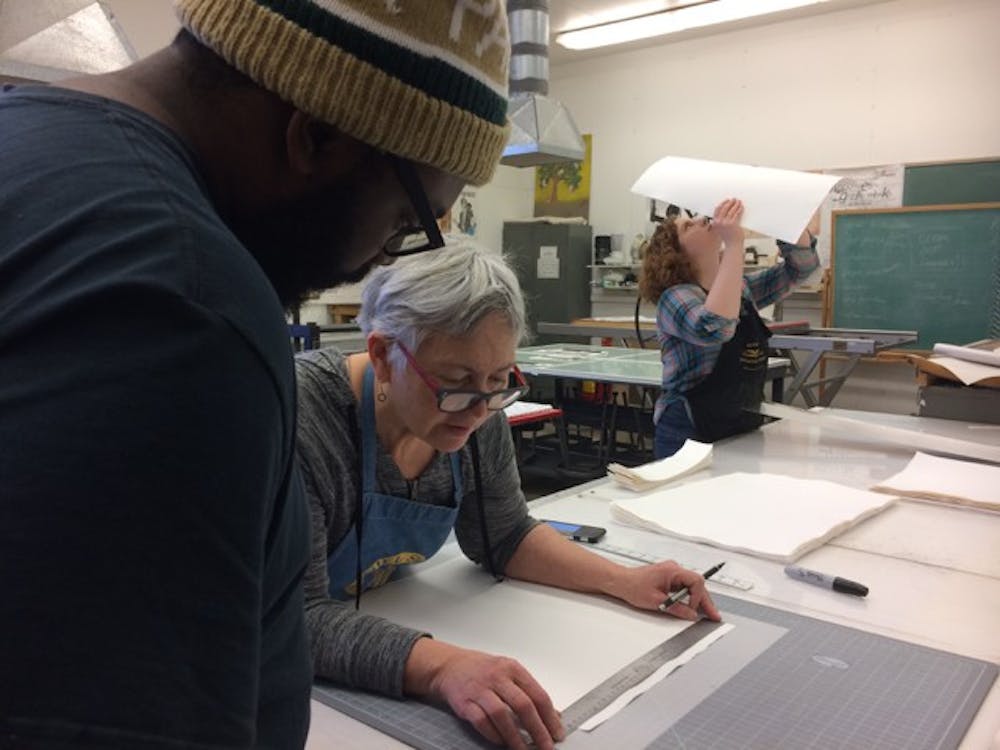ASU’s School of Art graduate students are working together with Native American artists to create intricate pieces of art displayed at ASU Art Museum as part of the biennial Map(ing) art exhibit.
Map(ing) was established in 2009 to explore Native American culture and history. It also showcases the artist’s personal ideas and vision through the students’ visual storytelling and screen printing. The name is an acronym for the full name of the project: Multiple Artists Printmaking (Indigenous and Native Geographies)
The Native American artists come to ASU with ideas based on their own art and studio practice. Together with ASU graduate students, they learn how to translate the idea into a printmaking medium.
Mary Hood is the project director for the exhibition and a professor of art in printmaking. Map(ing) is not Hood’s first cultural art project. In 2005, she led the RIPPLE project featuring donated prints from student and professional artists to bring awareness to the victims of Hurricane Katrina.
She said it was the students’ experience in printmaking that allowed the artwork to come alive for the Map(ing) exhibit.
Heather Lineberry, ASU’s senior curator, who organized the exhibit, said the actual collaborative work was undertaken over the course of 10 days by students who volunteered their winter break for the project.
“It’s the (students) that handle technical work, and creating the necessary vision and ideas for a piece (is the visiting artist’s job),” she said. “Printmaking is a collaborative work that requires a team of artists to produce a print.”
Jonathan Wright, one of the graduate art students, said the experience was a teaching experience for him.
“We learned from each other, learned from different artists,” he said. “I learned from my partner, she learned from me, and we learned from Brenda (one of the visiting artists), so it was pretty much a big learning triangle.”
This year’s visiting artists include Hannah Claus, Cannupa Hanska Luger, Brenda Mallory, Rory Wakemup, and the returning artist Sarah Sense.
“The (Native American) artists in question aren’t necessarily familiar with printmaking,” Luger said. “I work with ceramics artists and sculpture, primarily…..I was never a big fan of printmaking because of the large equipment.”
But, he said he enjoyed working with the students for the project and coming up with a piece they all enjoyed.
Luger’s collaborative piece is a print inspired by Eadward Muybridge’s Galloping Buffalo.
He says that the buffalo resonated with him because he hails from North Dakota and his people are “buffalo people.”
The piece was made by layering seven of the galloping buffalos in varying positions into one print.
Mary Hood said she believes that the project’s aspect of meeting professional artists and discovering new ideas was a quintessential part of the learning experience for the developing artists.
"Students (being) exposed to ideas, techniques and ways of approaching artwork is beneficial to them," she said. "They just can’t learn everything from one person.”
Employees at the ASU Art Museum said The Map(ing) exhibit has been very successful and has attracted a good amount of people.
“(The Map(ing)) exhibit has gotten a lot of traffic lately,” said Cole Childress, a museum receptionist who monitors guest activity at the museum. ”People come in specifically looking for that one.”
Once the exhibit ends, the prints will be archived at ASU’s print collection until the next Map(ing) event comes in 2019. The original impressions of the prints will be given to the visiting Native American artists.
The exhibition runs from Dec. 17 to May 20 at the Arizona State University Art Museum.
Reach the reporter at mffelix2@asu.edu or @MJ3Felix_on Twitter
Like The State Press on Facebook and follow @statepress on Twitter.





